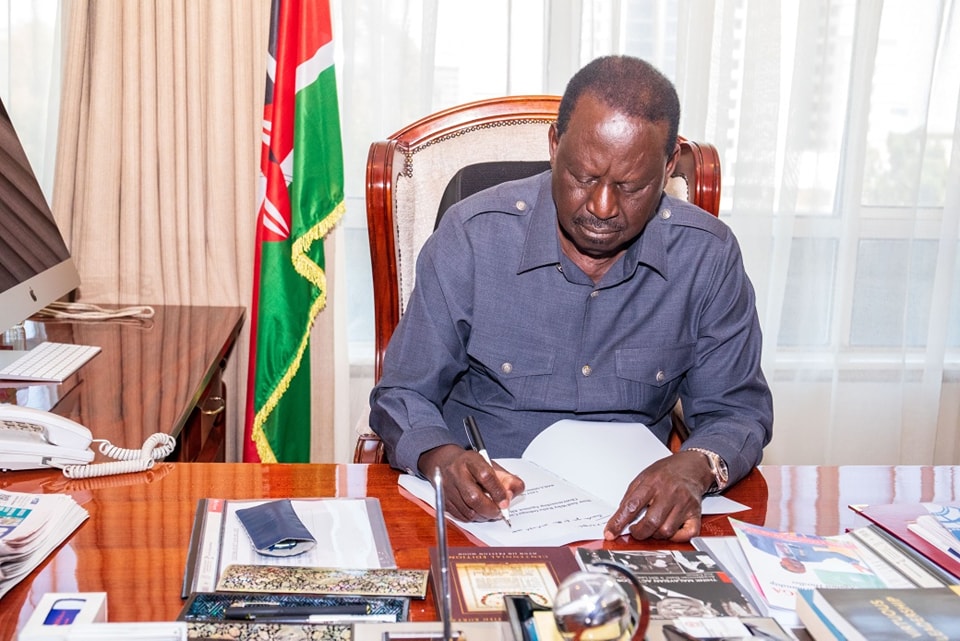Who Is Raila Amolo Odinga?
Raila Amollo Odinga, popularly known as ‘Baba’, “Agwambo”, “Tinga”, and now the ‘5th’, is the son of the late first vice president Jaramogi Oginga and Mary Juma Odinga, he was born on 7 January 1945.
His father served under President Jomo Kenyatta. He is a member of the Luo ethnic group.
FAMILY
Raila is married to Ida Oyoo, they have four children, the late Fidel Castro, Rosemary Akeyo, Raila Junior, and Winnie Irmgard.
The late Fidel was a businessman and a solid pillar in his father’s political endeavors, Rosemary is a passionate educationist serving as the Director of the Raila Odinga Center.
Raila Odinga Jr is a businessman with varied interests from energy to entertainment.
Winnie serves as the Director of Green Outreach Foundation Africa, an initiative centered around renewable energy to meet the emerging demands of the modern-day world.
EDUCATION
Odinga went to Kisumu Union Primary, then later Maranda High School for secondary education.
In 1962 Odinga traveled to Germany where he was admitted to the Herder Institution.
While in Germany, Odinga got a scholarship at the Technical School, Magdeburg, which is part of the philological faculty at the University of Leipzig in East Germany.
He later graduated with a Master of Science in Mechanical Engineering in 1970.
He then traveled back to the country and established East African Spectre, a company that manufactures liquid petroleum gas cylinders.
POLITICAL CAREER
The former premier's position as the Group Standards Manager at the Kenya Bureau of Standards (KEBS) when he was the Deputy Director in 1978, paved the way for him to start his political activism standing against the then dictatorial rule by KANU, Moi’s regime.
His activism led to his arrest which he was placed under house arrest for 7 months by former President Daniel Moi.
Azimio One Kenya Presidential hopeful was later charged with treason and detained without trial for six years. During his time in detention, his mother died in 1984.
Odinga was released on February 6, 1988, but re-arrested in September the same year and released on June 12, 1989, only to be locked up again on July 5, 1990, this time with Mr. Kenneth Matiba and Mr. Charles Rubia during the agitation for multi-party democracy.
He was released on June 21, 1991, and fled the country for Norway the following November amid fears of another arrest.
Raila returned to Kenya in February 1992 and joined Forum for the Restoration of Democracy (Ford), where he was elected Vice Chairman of the General Purposes Committee of the party.
He ran for Langata MP Seat in 1992 on a Ford Kenya ticket and took the lead.
He resigned from Ford-Kenya to join the National Development Party (NDP) after losing the bid as the Ford Kenya chairman to the late Kijana Wamalwa after the demise of his father.
In 1997 he contested for the presidency and finished third but maintained his MP seat at Lang'ata.
He served in Moi’s Cabinet as Energy Minister from June 2001 to 2002.
He fell out with the late president Moi after he endorsed Mr. Uhuru Kenyatta as his successor.
Odinga, Kalonzo Musyoka, the late George Saitoti, and the late Joseph Kamotho, opposed this step and joined the Liberal Democratic Party (LDP) which teamed up with Mr. Mwai Kibaki’s National Alliance Party of Kenya (Nak), a coalition of several other parties, to form the National Rainbow Coalition (Narc).
In 2007 he contested for the presidency which he lost to Mwai Kibaki, an election which was marred with violence hence sharing of power as a Prime Minister and Kibaki as the President.
In the 2013 elections, Odinga’s ODM formed the Coalition for Reforms (CORD) alliance with Kenyan former Vice Pres. Stephen Kalonzo Musyoka’s Wiper Democratic Movement and other parties.
Among the eight presidential candidates, Odinga and Kenyatta were at the forefront of the March 4 election, which transpired with relative calm.
After a delay in the release of the final results, due to problems with the vote-tallying process, electoral officials announced that Odinga received 43.31 percent of the vote, placing second to Kenyatta, who was finally declared the winner with 50.07 percent of the vote.
In the 2017 elections, Odinga’s ODM party and the other parties that were previously part of the CORD coalition allied with more parties to form the National Super Alliance (NASA).
They lost the election to Jubilee and cited alleged irregularities to an extent of calling for a repeat, the case ended up in the Supreme Court and a repeat was carried out which saw President Kenyatta carry the day as Odinga had boycotted.
In early March 2018, Odinga and Kenyatta reconciled a move popularly referred to as “the handshake” hence working together during the Building Bridges Initiative.
In December 2021 Odinga formally declared his candidacy for president in the 2022 election under the Azimio One Kenya Coalition.
Tags: Raila Odinga Who Is Raila Raila'S Biography


